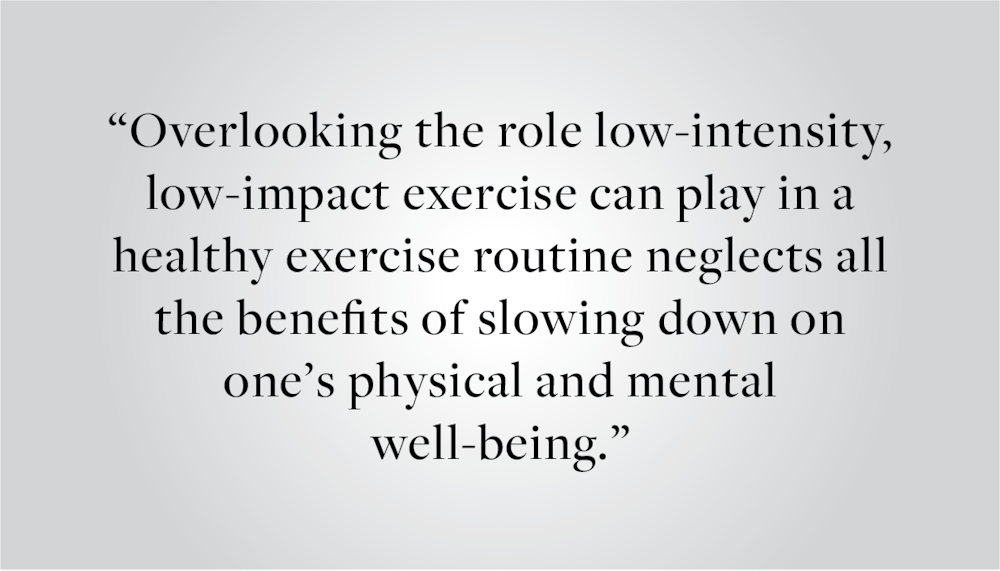On a fateful skiing trip this winter break, I tore my anterior cruciate ligament — more commonly known as the ACL — on a sharp turn and had to be transported down the slopes in a snowmobile. It wasn’t the pain or upcoming surgery that crushed me most about the injury — it was the half-marathon I wasn’t going to run in May, the mountains I wouldn’t climb this summer and the weights I couldn’t lift that disappointed me the most. Coming from an active family, it was hard for me to accept a new reality without the high-impact and high-sweat activities that made me feel the strongest.
Since my surgery, I’ve modified my daily physical activity significantly. Instead of long runs around Providence and heavy lifting at the Nelson Fitness Center, I’ve switched to low-intensity and low-impact exercises such as Pilates, light weights, yoga and lots of walking. To my surprise, I feel great. I’ve been able to work new muscles and challenge myself without the risk of further knee damage. Because of my injury, I’ve realized that low-intensity and low-impact exercise is far from being low-effort or low-reward. Participating in gentler forms of exercise can be just as engaging as high-impact activities without wearing out joints and muscles.
Low impact refers to the force the joints endure during exercise, while low intensity refers to the level of difficulty and exertion required to perform an activity. For example, running is a high-impact and high-intensity exercise, while cycling is a low-impact but potentially high-intensity exercise. Activities such as yoga and walking are considered low-impact and low-intensity.
Unfortunately, “low-impact” and “low-intensity” are somewhat loaded terms, since the activities they encompass can be viewed as inferior to more rigorous activities, such as running or high-intensity interval training. In the past, I would gauge the effectiveness of a workout by the amount of pain I had endured or how much I had sweat. However, training hard every single day without incorporating gentler movements can disrupt hormonal function and lead to overuse injuries, especially to the knees and shoulders.
When we perform a high-intensity and high-impact activity, our brain releases cortisol, a stress hormone, to make the body’s energy sources more available for use. While increased cortisol levels can boost immunity and reduce inflammation, too much cortisol in the long run can backfire and lead to a worsened immune system, chronic fatigue and mood swings. It can also lead to amenorrhea, or loss of the menstrual cycle.
Low-impact work can offer similar benefits to high-impact work without many of the potential negative consequences, and is especially accessible to older individuals or those recovering from injury. Low-impact work such as swimming or stationary cycling can still raise the heart rate, improve cardiac function and help manage weight without the physical demands of high-impact activity. The main difference is that low-impact work allows individuals to be more consistently active. There is a shorter recovery period from low-impact work, so individuals can take fewer rest days and more easily maintain healthy lifestyles. For instance, it can be difficult for someone to run every single day since it is so physically demanding. Breaking up days of running with swimming and cycling can make exercise more interesting and sustainable in the long term.
Low-intensity work also offers important benefits. Participating in activities such as yoga and Pilates improves posture, flexibility, stability and strength while mitigating joint pain and improving stiffness after injury. Pilates can build muscular endurance by targeting different areas than high-intensity workouts do. These low-intensity exercises also stress mindfulness, which can help mental health through breathing and relaxation techniques. Since minimal equipment is required and many tutorials exist online for beginners, Pilates and yoga are easily accessible for most people.
There is no one correct way to maintain a healthy lifestyle, but overlooking the role that low-intensity and low-impact exercise can play in a healthy exercise routine neglects all the benefits of slowing down on one’s physical and mental well-being. It’s true that I feel the strongest while running or sweating up a storm, but engaging in gentler forms of exercise has made me more attuned to my body’s needs and limitations. Pilates may not give me the same endorphin-filled rush as a good run, but taking time to discover new ways to move is exciting and will keep me occupied as I recover from surgery. In the meantime, the half-marathons, mountains and deadlifts will have to wait.
Juliet Fang ’26 can be reached at juliet_fang@brown.edu. Please send responses to this opinion to letters@browndailyherald.com and other op-eds to opinions@browndailyherald.com.
Juliet Fang is a second year at Brown studying Ecology and Evolutionary Biology. In her free time, she enjoys running, cycling, and watching duck videos.





